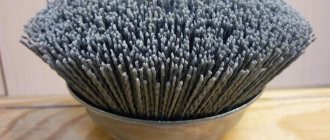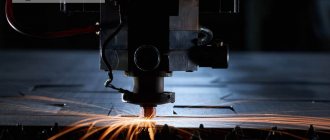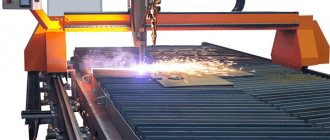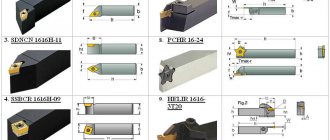Every man has held pneumatic tools in his hands at least once in his life. Using them correctly can make your life a lot easier as they have many functional uses. Of course, taking into account the specifics of the tool, we can safely say that it is not always worth buying pneumatic tools for the home due to the fact that they are rarely used. But if you like to tinker and repair, you should think about buying pneumatic tools. If you want to renovate your apartment or equip your own auto repair shop, then such tools will come in handy, and you don’t have to buy new ones, you can use the services of the company pnevmoportal.ru, which rents out pneumatic tools. But before that, let's try to figure out what we need and what types of pneumatic tools exist on the market.
Drills
The simplest pneumatic tools available on the Pneumoportal include drills, which are used for drilling holes. Depending on your needs, you can use both powerful professional models and amateur ones. They differ mainly in power and endurance. There are also pneumatic drills available on the market that differ in the number of revolutions per minute.
General brands[edit]
- Chicago Pneumatic
- Kirloskar [8] Pneumatic
- AIMCO
- AIRCAT
- Apex Tools Group
- Atlas Copco
- ZIPP GROUP
- Campbell Hausfeld
- 3 million
- China pneumatic
- Compair Broomwade Ltd
- Craftsman
- DeVilbiss Air Power Company
- Festo
- Husky (tools)
- Ingersoll-Rand
- JET
- Cobalt (tools)
- Mac Tools
- Master Palma
- Makita
- Matco Tools
- Osaka
- Patco Air Tools
- Porter-Cable
- RAD Torque Systems
- Click on
- ZIPP TOOL
- Katashi
- [SUMAKE]
- Nex Flow
- Universal tool
Screwdrivers, screwdrivers, angle grinders
There is also a wide range of pneumatic screwdrivers, screwdrivers and even angle grinders on the market. They are chosen everywhere mainly because of their high reliability and trouble-free operation. Moreover, it should be noted that compared to electric or cordless screwdrivers, screwdrivers or drills, pneumatic ones are more powerful, which is important when carrying out many jobs.
Design and operation of pneumatic tools
A worthy analogue of hand-held power tools is pneumatic equipment. Due to the fact that the design and operation of pneumatic tools compare favorably with electric analogues, these devices are becoming increasingly used and popular in a wide range of work.
The most obvious difference between pneumatic tools and electrical equipment is the energy source. As you might guess, the energy for these devices is compressed air, which is supplied through a flexible hose with a diameter of one and a half to two centimeters. The average length of a hose is about fifty meters; it is not uncommon to find a hose rolled into a spiral accordion - in this way the hose is significantly reduced in length and can be extended to the required distance without much effort. The ends of the hose are equipped with couplings for easy disconnection and connection of the tool to the pneumatic line or directly to the compressor.
Here you can familiarize yourself with the catalog of pneumatic tools sold by TekhMash Group of Companies LLC.
A pneumatic tool differs from an electric one in that it is lighter than the second one, since there are significantly fewer parts in the drive mechanism and the dimensions of electrical devices are larger than pneumatic ones. It follows from this that when using air-powered tools in work, the worker will be less tired. Due to their compactness, but without loss of power, pneumatic tools are often used in confined spaces. Another very useful factor is that the engine of such a tool does not produce sparks, which means it can be safely used in explosive areas with high gas contamination. The worst thing for a power tool is moisture getting inside. The electric motor instantly fails, but for an air-powered tool, water cannot be a hindrance. With such an assistant you can easily work in pouring rain, and in some cases even under water. The pneumatic tool is not afraid of overheating, and eliminates the possibility of ignition due to a short circuit in the wiring. And it is very important that a pneumatic tool will never cause an electric shock.
Due to the fact that the design and operation of pneumatic tools are unique in their own way, the scope of application of such equipment is practically unlimited. However, pneumatic devices have become widespread at stationary production sites, in workshops, factories and factories. In addition, such tools are also widely used in everyday life. The mobility of pneumatic tools depends only on the transportation of the compressor; if this does not cause problems, then all other organs will not cause trouble.
The service life of pneumatic equipment also meets all requirements and significantly exceeds that of electric tools. Sometimes the service life is tens of times longer than machines of equal power. This is one of the main qualities for which pneumatic tools are so loved by professionals and inexperienced craftsmen. In addition, such a tool has fewer parts, which means there are fewer possible breakdowns. And if they break down, pneumatic devices can easily be repaired on site, of course, if you have the necessary spare parts and the right tools. An example is a hand-held pneumatic drilling machine:
1 is the spindle; 2 – planetary gearbox; 3 – rotary type pneumatic motor; 4 and 11 are screws; 5 – nut; 6 – equipment handle; 7 – starting device; 8 – muffler, which allows to significantly reduce the noise level of equipment operation; 9 – union nut; 10 – gear housing.
The design and operation of pneumatic tools can be considered in more detail using the example of a rotary pneumatic motor. The design of a rotary air motor is very simple. It consists of only a few working elements. This is the housing or, as it is also called, the stator, rotor, plates, air supply and exhaust channels. How does it all work? The rotor body has grooves (slots) into which plates are inserted. Circular motion is carried out due to the expansion of the compressed air medium. The rotor is slightly offset relative to the center of the stator. This creates zones inside the stator with different volumes. The plates play the role of dividing partitions between these zones. The air supply is directed to the area with the smallest volume, and the outlet is located in the largest area in the stator cavity. Compressed air turns the rotor, tending to increase volume and release internal tension. The displacement of the air flow determines the direction of rotation of the rotor.
Speed regulation is carried out by increasing and decreasing pressure. This means that the use of a gear transmission system is not necessary, which has a great effect on the weight of the tool.
In addition, the operation of a pneumatic motor is very different from electric motors in that as the load increases and the speed decreases, the power of air pressure on the rotor plates increases and thus the power increases, which, unfortunately, is inversely proportional to electric motors. Thus, the constant load on the air motor is not dangerous for the service life of the tool, even over several shifts continuously.
The level of vibration and noise is lower than that of a power tool; loud noise is created only by the compressor unit, and if you isolate the compressor from the workspace, then this problem will be resolved.
In addition, pneumatic equipment has significant savings in energy costs, approximately thirty percent. Only the compressor needs to be powered with electricity; all other tools will be powered by compressed air.
To work with pneumatic tools you do not need to have any special skills - its design and operation are quite simple. Modern models are made with maximum ergonomic design, they are comfortable to hold in the hand, they are pleasant and easy to work with.
Staplers and nailers (guns for hammering nails)
Pneumatic staplers and nailers are also not often used at home, although they are indispensable in some cases, for example, when building a gazebo. A pneumatic nailer can be used to drive nails into boards, and a stapler can be used to attach roofing felt to the roof. In principle, nailers may be required wherever nails need to be hammered in large quantities. We are, of course, talking about specialized production enterprises. Staplers may be needed in the production of furniture in which it is necessary to fasten upholstery. These tools have undoubtedly proven their reliability and always provide good results.
Important nuances
So, now that all the advantages of pneumatic tools are as obvious as the advisability of using them, it’s worth taking a closer look at the recommendations for choosing them. After all, the reliability and service life of such units depends on how high-quality the compressed air is supplied. And from this it follows that air treatment systems must provide not only stable pressure, but also clean the air and dry it.
The concept of systems means a compressor and separator, a receiver, cleaning filters, moisture separators, dryers, lubricators, pipes, fittings and, of course, hoses through which air will be supplied. All these elements are required in order to create a complete pneumatic network.
The compressor is selected taking into account the air flow required for pneumatic equipment with a mandatory margin of thirty percent. Naturally, the greater the reserve, the longer the service life of the compressor and pneumatic tool.
If you don’t want to create a stump network, then you can get by with periodic lubrication of the tool. But at the same time, the issue of dust and moisture will be relevant, which will negatively affect the operating life of the units. However, even in this case, the service life will still be much longer than that of electric analogues.
If the tool is used in large enterprises, then the compressed air is transported through metal pipelines, to which hoses are connected, connecting the line directly to the tool. The hoses themselves are made of nylon or polyurethane. Moreover, they must be spiral. Polyurethane hoses withstand aggressive environmental influences. They are not afraid of abrasion and mechanical stress.
It is very important that air treatment systems are adjusted to the individual needs of each individual enterprise. Therefore, during the configuration process, it is necessary to carefully study what this or that element of the system is intended for.
When using a pneumatic tool, you need to remember that it can fail if errors are made during operation. Therefore, compressed air must contain lubricant, and it follows that a lubricator must be built into the pneumatic system. But only if we are not talking about a spray gun. Oil emulsions will have an extremely negative impact on the quality of painting. However, in all cases, the air needs to be cleaned of mechanical impurities and dried, since moisture can cause corrosion of the pneumatic drive.
It is quite obvious that there is no way to save on air treatment. After all, any simplification can cause failure of the unit. Therefore, scrupulously following all the manufacturer’s recommendations will ensure a long life for the instrument.
About security
The issue of pneumatic tool safety is also very important. We talked a lot about reliability and long service life, but the safety of the master is also important. But in reality, everything here is very rosy. After all, the likelihood that the user will receive an electric shock is completely eliminated, just like the risk of sparks. Especially when it comes to using grinders. The absence of sparks reduces the likelihood of a fire.
At the same time, pneumatic tools are very ergonomic. It makes less noise during operation, has less weight and dimensions. Accordingly, it is much easier for them to work - the user gets tired and tense less, and these are the main sources of injuries.
In addition, it is worth remembering that a jet of compressed air should not be directed at people. It is also important that the pneumatic line, tubes, etc. should not be blocked by hands. And before connecting the device to a compressor or air supply system, you must check all the fastenings.
Video. Advantages and disadvantages of pneumatic tools
Compressors and autocompressors
The group of pneumatic tools even includes compressors and auto-compressors, which are also available on the Pneumoportal. As a rule, they have a surprisingly low noise level and have a valve to drain condensate and relieve excess pressure.
Types and types of pneumatic powered tools
By purpose, rotary-plate and impact instruments can be distinguished. A separate group includes spraying devices used for uniform distribution of paint, abrasives of various dispersions and lubricants (most often these include various types of pneumatic guns).
Classification by type of pneumatic tool:
- For passenger tire fitting;
- Compact;
- Ultra-compact;
- For passenger and commercial vehicles;
- For truck tire fitting;
- Sandblasting guns;
- Grinding pneumatic tools;
- Drills;
- Hammers;
- Staplers.
Sandblasting gun with a 1000 cm3 tank More details
Pneumatic impact wrench 1/2″ 680 Nm, compact Read more
Types of pneumatic tools:
- professional;
- semi-professional;
- domestic.
Household samples include low-power devices, for example, a stapler or drill. Examples of semi-professional devices would be compact and ultra-compact impact wrenches. Professional pneumatic tools are characterized by high operating pressure and torque.
Jackhammers
The most famous pneumatic tool is probably the jackhammer. Surely you have seen workers using this type of tool. As a rule, they have special headphones and a helmet, since this type of instrument is characterized by a high noise level. Pneumatic jackhammers are irreplaceable in certain situations, and are also useful for workers carrying out road work, as they significantly facilitate work. You can also rent jackhammers on Pneumoportal; the existing selection of power will allow you to choose the model that is suitable for your specific tasks.
Air motor
Pneumatic motor (from the Greek pneuma - blow, air), pneumatic engine, pneumatic motor - an energy-power machine that converts the energy of compressed air into mechanical work.
Based on the operating principle, a distinction is made between positive displacement and turbine air motors. In the direction of movement - linear (piston, balloon, membrane and others) and rotary (piston and blade).
In volumetric pneumatic engines, mechanical work is performed as a result of the expansion of compressed air in the cylinders of a piston machine; in turbine engines, as a result of the action of air flow on the turbine blades (in the first case, the potential energy of the compressed air is used, in the second, kinetic energy). The most widespread are volumetric air motors (piston, rotary and chamber (balloon)).
Pneumatic motors are used to drive various tools (drills, impact wrenches, jackhammers, grinding heads), ensuring safe work in explosive areas (with accumulation of gas, coal dust), in environments with high moisture content.
How does a lubricator for pneumatic tools work?
This device is a reservoir, the body of which is made of metal, which is put on the inlet part of the pneumatic equipment and fixed to a threaded connection. When installed, the lubricator is placed after the filter, which is necessary to dry the air flow. After the air gets inside, it is enriched with oil particles and goes further into the tool itself.
It is very important that the distance of the hose between the lubricator and the device itself is no more than 10-12 meters: with a longer length, the distribution of oil with air is not as effective, and condensation begins to form on the walls, reducing productivity. If this length is not enough, it is better to use linear type lubricators, which are installed directly in front of the tool.
Modern devices may differ in thread size, construction materials and the volume of the storage tank into which oil is poured before use. In addition, devices can be single-point or multi-point, and the choice of equipment is made taking into account the characteristics of future operation. Among other things, devices are divided into two groups according to type of design:
- Lubricator filters, which are mounted on the tool itself between its handle and the hose for air flow.
- Air accessories installed on a compressor or flow distribution system.
The operating principle of a pneumatic tool is quite simple; the whole secret is in the compressed air that comes from the compressor through a high-pressure hose to a special engine. The compressor that compresses air can have either an electric, diesel or gasoline engine. It is worth noting an important advantage of how pneumatic tools work - they themselves do not consume electrical energy at all.
The compressor housing consists of a high-quality aluminum alloy, but all its parts are made of hardened structural steel. Thanks to the good processing of the parts and their mobility, the tool itself works very quietly, although sometimes the opposite may seem, but this is due to the type of work itself, and not to the tool. Vibration depends on how well the parts were made and how many gears are in the structure itself. Higher quality and more expensive pneumatic tools work with very little vibration, because there are no gears at all.
As you can see, the operating principle of a pneumatic tool is very simple - it completely depends on the pressurized air, which, according to the type of the tool itself, causes the desired mechanism to operate (the most common of which are impact, rotation or injection).
The cost of the tool and what affects it
Once a specific model has already been selected, employees must choose the most relevant cost that will pay for itself quickly. Need a cheap product? It is better to look for a product with low-quality materials. But you have to be careful. If moisture gets on low-quality metal, it can cause corrosion.
Do you need a brand from a domestic manufacturer? There are many suppliers on the Internet who install their devices at a lower cost than foreign companies.
Also, in simple construction stores it is easy to find a special device that meets the necessary standards.
Lubricators are also called oil sprayers and are designed to supply lubricant from a reservoir to the elements of a pneumatic system using a stream of compressed air. The supplied oil sprayers are of the ejector type. The air flow passing through the lubricator is divided into main and ejection.
The ejecting flow causes a local decrease in pressure due to an increase in the velocity head and the pressure difference between the oil reservoir and the spray chamber. This pressure difference is sufficient for the oil to rise up the vertical tube and then through the throttling channel and the curved tube to enter the spray chamber in the form of drops. In the chamber, the oil is atomized in the air flow and enters the main air flow in the form of oil mist, which enters the pneumatic system.
Currently, it is recommended to use as little lubricant supply to the pneumatic system elements as possible, since in such systems liquid lubricant is released into the atmosphere. The use of lubricators in pneumatic systems is mandatory in cases where the system has already used oil spray devices, when the system uses pneumatic cylinders in steel casings, and when the system requires high speeds of movement of the cylinder rod and large diameter pneumatic cylinders are used.
How to choose pneumatic tools
The main criteria for choosing a pneumatic tool will be its following characteristics:
- power
; - productivity
, including the presence of manual speed control, precision adjustment of the position of the cutting tool and the ability to quickly replace it; - convenience
- weight, location of control elements, permissibility of using a balancer, etc.; - price
- in addition to the cost itself, the terms and conditions of delivery, guarantees and the location of the nearest service station are taken into account.
Examine the body of the pneumatic tool offered by the seller and its magazine part - the fewer plastic inserts, the better; most of the body elements should be made of metal. Evaluate how accurately the body elements fit, make sure there are no holes or cracks on it. It should be noted that when choosing a pneumatic nailing tool, it is better to give preference to models with a magazine for which the fastener is a drum nail or drum nails. Since pneumatic tools constantly require specialized fasteners (a certain staple width or nail length), it would be wise to choose a supplier that provides the required range of high-quality consumables at reasonable prices.
Operating principle: pneumatic or cordless (gas)
There are two fundamentally different sources of energy for a pistol - pneumatic (air) and gas, powered by the detonation of a portion of gas, like your car. Pneumatic nailers require a compressor (which is a separate study to purchase), hoses, and other accessories. A more expensive option than pneumatics would be gas or cordless versions of the gun, which operate from the detonation of a small portion of gas from a can in the combustion chamber. This is convenient when increased mobility is required. But we must remember that mobility is good, but gas cartridges will cost more than electricity for a compressor; when choosing, you should think about the fact that the cost of a pneumatic tool compressor is more profitable when the tool is used intensively.











